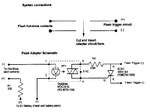Robin Zaalberg
Newbie level 3

- Joined
- May 6, 2015
- Messages
- 3
- Helped
- 0
- Reputation
- 0
- Reaction score
- 0
- Trophy points
- 1
- Location
- The Netherlands
- Activity points
- 30
Hello forum,
This is my first post on EDABoard since I made an account for this question specifically. Please, if I don't obey a rule of this forum or do something wrong, please correct me. Now here comes my question:
I have recently bought a new DSLR and had an old Sunpak Auto 431 flash unit lying around for it. The problem is that the trigger voltage of the Sunpak is too high; it can damage flash components in modern SLRs. I measured the voltage of the flash between 30-50 volts. My camera can accept only 12-24 volts. Although some people on the internet have claimed that the Sunpak does no harm, I still want a 0% chance of damage. I did some research and found the following circuit on **broken link removed**:
First question: Further on the page it says 'You may need to use a different value for R2 for your particular flash and SCR, since this is based on a 218 V trigger voltage.', which makes me wonder what value I need for my 30-50V. Will I need to change the value of the resistor to make this circuit work effectively? And what value will I need?
Second question: I have been looking around in several webshops and saw there are different wattages for resistors. Will I be fine with the cheapest (.25 W, carbon-film) or do I need metal-film or higher wattage?
Third question: One shop I had been looking through recommended a heat sink for the diode (SCR). Do I really need that? — Look, the .30$ won't make me poor, but I'd like to make the circuit as small as possible. And if I do, do I need thermal compound for that?
Thanks in advance for reading though my tiny problems and your solution.
Faithfully yours,
Robni7
This is my first post on EDABoard since I made an account for this question specifically. Please, if I don't obey a rule of this forum or do something wrong, please correct me. Now here comes my question:
I have recently bought a new DSLR and had an old Sunpak Auto 431 flash unit lying around for it. The problem is that the trigger voltage of the Sunpak is too high; it can damage flash components in modern SLRs. I measured the voltage of the flash between 30-50 volts. My camera can accept only 12-24 volts. Although some people on the internet have claimed that the Sunpak does no harm, I still want a 0% chance of damage. I did some research and found the following circuit on **broken link removed**:
First question: Further on the page it says 'You may need to use a different value for R2 for your particular flash and SCR, since this is based on a 218 V trigger voltage.', which makes me wonder what value I need for my 30-50V. Will I need to change the value of the resistor to make this circuit work effectively? And what value will I need?
Second question: I have been looking around in several webshops and saw there are different wattages for resistors. Will I be fine with the cheapest (.25 W, carbon-film) or do I need metal-film or higher wattage?
Third question: One shop I had been looking through recommended a heat sink for the diode (SCR). Do I really need that? — Look, the .30$ won't make me poor, but I'd like to make the circuit as small as possible. And if I do, do I need thermal compound for that?
Thanks in advance for reading though my tiny problems and your solution.
Faithfully yours,
Robni7

